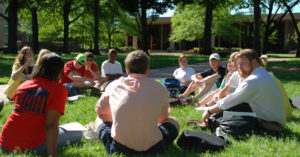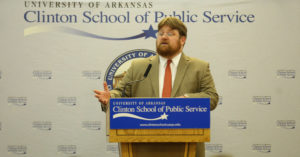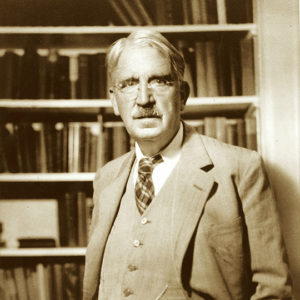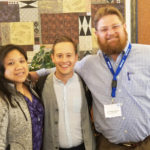Both the Mishna (Sanhedrin, 4) and the Quran (5:32) advise that to kill one person is like killing all human beings.* The Mishna says that God created humanity in the form of one original person to remind us of that fact. It means that when Henry VIII had Thomas Cromwell’s head chopped off on July 28, 1540, Henry destroyed a whole world.
Hilary Mantel proves this fundamental moral truth by richly imagining the inner life of the Tudor politician in the three volumes of her Wolf Hall trilogy. The main character (almost always called “he,” without a name), progresses through time and interacts with other people like an ordinary fictional protagonist, but often the narration traces his mind as it jumps to the past or envisions possible futures. Much of the trilogy is devoted to daydreams.
Cromwell is an unlikely candidate to be liked–a shrewd and sometimes ruthless political actor, a Protestant fundamentalist (in our terms), and a royalist. He’s also poorly documented. Most people have seen him as the villain or–at best–the cipher who killed Thomas More and Anne Boleyn. His portrait by Hans Holbein makes him seem private and distant. He is literally set further away than Holbein’s other subjects.
I’m guessing that is why Mantel chose him: to exercise her genius for sympathetic imagination. She must invent most of his past and his inner life, presenting a whole subjective world that would otherwise be opaque. We care for Cromwell not because we agree with him or have behaved like him, but because we can see a whole world through his eyes.
Mantel’s imagination is extraordinary, whether she is conjuring ordinary physical things like plums and footstools or spinning stories around the documented facts. Just for example, Elizabeth Seymour is sure she has been chosen to marry Thomas Cromwell. But he has invited her to marry his son. They talk at cross-purposes for a whole conversation until the awkward misunderstanding dawns on both of them. Who but Mantel would have thought to insert that twist?
In his essay “The Storyteller,” Walter Benjamin explores a distinction between a story and a novel. A story is succinct, vivid, subject to many interpretations, meant to be remembered in full and retold to others. It is a communal object, recited orally to a group of people who enjoy each other’s company as they listen and speak in turn.
In contrast, a novel is profoundly individual, a silent communication from one author to one reader at a time. It provides so much detail and interpretation that the reader’s creativity is constrained by the author’s intentions; and it’s too long and carefully constructed to be paraphrased, let alone memorized and retold. Although novels have diverse subjects, the classic topic is one person’s inner life as he or she progresses toward a conclusion; and the clearest conclusion is death. Don Quixote is the “first great book of the genre.”
The novel arises once words can be mass produced for private consumption. It is a capitalist object, meant for a market. It also arises when people become truly afraid of death–not just of dying, but of observing and talking about death. “Dying was once a public process in the life of the individual and a most exemplary one.” But in the bourgeois 19th century, “the general consciousness the thought of death … declined in omnipresence and vividness.” The novel fills a gap by allowing us to imagine the death of an individual who is safely fictional as a way of contemplating our own mortality.
In a story, the hero is admirable beyond realism but hard to imagine from the inside. In a novel, the protagonist is flawed, and the more you read, the more flaws you see. Don Quixote “teaches how the spiritual greatness, the boldness, the helpfulness of one of the noblest of men, Don Quixote, are completely devoid of counsel and do not contain the slightest scintilla of wisdom.” Yet we identify with the protagonist because her or his life functions like ours. Any life is a vast array of experiences, memories, and hopes, banal in their totality but unique in their details. A novel consoles us by implying that our life, too, is worthy. Benjamin says:
To write a novel means to carry the incommensurable to extremes in the representation of human life. In the midst of life’s fullness, and through the representation of this fullness, the novel gives evidence of the profound perplexity of the living.
A life is coherent because the present person has memories of her or his own past. Each of us has a unique collection of memories, and we are sufficiently attached to it that we are sad to think it will vanish with our deaths. We vainly counter that fate with monuments and memoirs and by boring children with our recollections. But a novel allows us to see someone else’s memories as a permanent object:
“No one,” Pascal once said, “dies so poor that he does not leave something behind.” Surely it is the same with memories too—although these do not always find an heir. The novelist takes charge of this bequest, and seldom without profound melancholy. …
The novel is significant, therefore, not because it presents someone else’s fate to us, perhaps didactically, but because this stranger’s fate by virtue of the flame which consumes it yields us the warmth which we never draw from our own fate. What draws the reader to the novel is the hope of warming his shivering life with a death he reads about.
Benjamin means to criticize the novel and lament the decline of the story. But his real target is capitalism, and the novel gets caught in the crossfire. Certainly, he understands what an achievement a novel is. And none seems to fit his theory better than Mantel’s trilogy.
Particularly as Cromwell approaches his end, he seems obsessive about cataloging his past, as if he could leave it as a coherent legacy. He thinks:
All your life you tramp the empty road with the wind at your back. You are hungry and your spirit is perturbed as you journey on into the gloom. But when you get to your destination the doorkeeper knows you. A torch goes before you as you cross the court. Inside there is a fire and a flask of wine, there is a candle and beside the candle your book. You pick it up and find your place is marked. You sit down by the fire, open it, and begin your story. You read on, into the night.
This scene of reading is exactly how Benjamin understands the novel, in general. It is a private experience of taking stock of a life to persuade oneself that it has meaning, even though each of us is but one among billions and fated to vanish.
Benjamin would probably emphasize that Thomas Cromwell was an early bourgeois, building a commercial commonwealth at the expense of the aristocracy and the clergy. Mantel describes foreign and court politics more than domestic policy, but the novel probably conveys–and it is plausibly true–that Cromwell revolutionized English society along bourgeois lines. That would make him a perfect choice for the protagonist of a Benjamin-style novel.
Benjamin doesn’t mention that Quixote is about two men, not one. So is the Wolf Hall trilogy. Cromwell tells Henry:
“What would I want with the Emperor, were he the emperor of all the world? Your Majesty is the only prince. The mirror and the light of other kings.”
Henry repeats the phrase, as if cherishing it: the mirror and the light. He says, “You know, Crumb, I may from time to time reprove you. I may belittle you. I may even speak roughly.”
He bows.
“It is for show,” Henry says. “So they think we are divided.”
As this passage suggests, Cromwell and Henry are mirror and light to each other. We can see their relationship either way, Cromwell reflecting the royal will or Henry shining because of Cromwell’s brilliance. Cromwell can also see himself as a combination of the mirror and the light. “The silver plate, reflecting himself to himself: the mirror and the light of all councillors that are in Christendom.”
As in the original master-slave dialectic, Henry needs Cromwell as much as vice-versa. Both are appealing in their respective ways, mixing needs and interests with a strong sense of responsibility. Each embodies his proper role–much like Archbishop Cranmer, who “does what is in him. It is all any man can do.”
It’s important that the trilogy is historical fiction. Mantel gives us access to an unfamiliar objective world along with an unfamiliar subjectivity. The implication is that a lifeworld can survive for five hundred years after the observer dies; maybe the same can happen to you or me. Yet the result feels fragile and precious, dependent on Cromwell’s survival as a character and Mantel’s art. That fragility charges the novel with suspense even though most readers will have a pretty good sense of how things must end. (Well, it’s how all things must end.)
Mantel has invented a diction to summon the world of her novel: 21st-century English that closely describes 16th-century England, with a dose of free indirect discourse (third-person narration that adopts some of the tone of the character being described). Clear anachronisms are rare and may be mistakes. “Why do we not, as the tennis players say, cut to the chase?” asks Ambassador Chapuys, using a phrase that originated in early Hollywood. Several characters refer wittily to the sentence, “Et in Arcadia ego,” which was coined ca. 1618. And Cromwell’s thought, “Florence made me … London unmade me,” suggests a reference to Purgatorio, V. 133, which only became famous after 1800. If these are flaws, they are tiny, and perhaps it’s best to think of the book as a loose translation of 16th century speech into modern English.
In sum, Mantel seeks to build something that is a terrible shame to end. That is exactly what we should say about any human life: even the life of a renaissance courtier who had many other people’s deaths on his conscience. In this sense, the novel is a moral achievement as well as a creative one.
*I ignore knotty questions about these two texts and how they relate. Most of the online commentary about them is sectarian and uncharitable toward other people’s faiths. Let’s assume that many Jews and many Moslems have read these passages in the way I am suggesting here.
See also: Hilary Mantel, Wolf Hall; Hilary Mantel, Bring Up the Bodies; history and fiction in Hilary Mantel’s A Place of Greater Safety; Calvino’s free hyper-indirect discourse; and Kieran Setiya on midlife: reviving philosophy as a way of life (with a digression on Benjamin and the importance of death in the novel). My own effort at a Tudor novel is The Anachronist. Finally, Clair Wills offers a much less favorable review in The New York Review. I don’t share her verdict, but she makes significant points.









